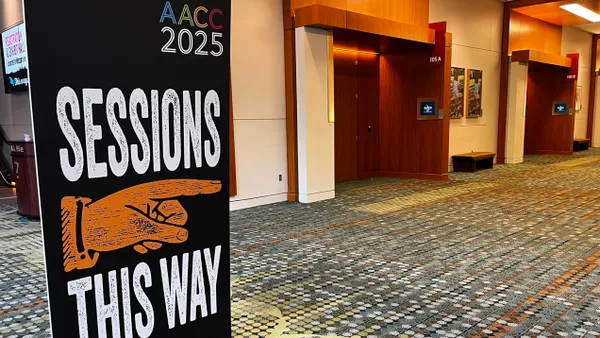Dive Brief:
- About 1.35 million students in the 2022 high school graduating class took the ACT college entrance examination, slightly more than in the previous year but far fewer than levels seen prior to the coronavirus pandemic.
- The test's provider, also called the ACT, shared the data Wednesday. About 54,000 more students took the ACT test in the 2022 school year’s graduating class compared to the 2021 class. But that’s far lower than the peak of nearly 2.1 million students in the 2016 graduating class who took the exam.
- Also on Wednesday, the test provider announced that the national average ACT composite score fell to 19.8 for the 2022 class, the lowest level in more than 30 years. The highest score a student can earn on the test is a 36.
Dive Insight:
The spread of the coronavirus shuttered common testing sites early in the pandemic, causing the ACT and the College Board, which administers the SAT, to bleed revenue.
Their financial pictures still look bleak, as the health crisis spurred widespread adoption of test-optional policies, in which colleges don’t require the SAT or ACT for admission. About 1,800 four-year institutions aren’t mandating entrance exams for the fall 2023 admissions cycle, including those that historically never asked for test scores. That’s according to FairTest, an organization advocating for restricted uses of standardized assessments.
Only a handful of institutions have revived testing mandates, among them the Massachusetts Institute of Technology, which said the exams can predict early academic success, as well as the Georgia Institute of Technology and the University of Georgia, two of the state’s most prominent public colleges.
Bob Schaeffer, FairTest’s public education director, pinned the decline in ACT exam takers to the proliferation of test-optional policies.
He noted taking the ACT without the writing section costs $63. Some students receive fee waivers, but the loss of hundreds of thousands of test takers over the last few years still adds up to millions of dollars of missed revenue for the ACT, he said.
ACT’s financial situation is particularly precarious because it banks on those testing fees as its primary revenue source, unlike the College Board, which makes money from other products like Advanced Placement exams.
The ACT has turned to voluntary resignations and other cost-cutting measures in the face of this financial stress.
Wednesday's figures signal continued headwinds for the testing provider. Rose Babington, ACT’s senior director for state partnerships, did not address a question Wednesday as to why the number of test takers has not rebounded.
In an emailed statement, Babington instead pointed to an area of growth for the test: ACT's State and District Testing program, which has students taking the test during regular school hours. In the high school class of 2019, the last before the pandemic, 40% of students tested at least once through that program. In this year's class, 60% did so, according to Babington.
ACT argues that testing during the school day expands access for low-income students, those in rural areas and students who would be first in their families to go to college.
Meanwhile, ACT chief executive Janet Godwin presented the average score decline as an academic crisis, one that predated the pandemic.
“A return to the pre-pandemic status quo would be insufficient and a disservice to students and educators,” Godwin said in a statement. “These systemic failures require sustained collective action and support for the academic recovery of high school students as an urgent national priority and imperative.”
Schaeffer, however, said falling scores make sense given the “unprecedented disruptions of education” in the past two years.
About 1.7 million students in the 2022 graduating class took the SAT, up by about 200,000 from the previous year’s class. Roughly 2.2 million students took the SAT in each of the 2019 and 2020 graduating classes.














